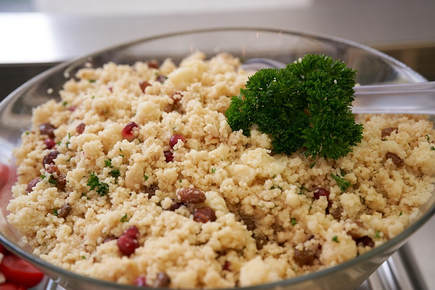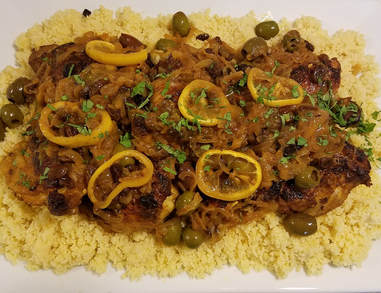What can a reluctant chef on a budget do or make to help provide that carblicious base that the crowd demands, is quick to make, but still keep things interesting? Enter a culinary wallflower to the rescue: Couscous
Couscous as a staple food is generally agreed to have originated as a Berber dish in Northwestern Africa in the region known as the Maghreb. It's believed to have come about around or before the 12th Century. A simple, nourishing, and easy to prepare food, couscous spread across Northern Africa and became a staple for many settled and nomadic communities in this region.
Usually made of durum wheat (the same variety used to make pasta), the semolina flour is mixed with water and rolled to form very small pearls of dough which are then dried. The pearls of couscous were originally hand rolled but today are almost exclusively made by machine.
It's also important to know there are two main varieties of couscous. "Regular" couscous is what you likely have encountered before or see at the grocery store. These are the very small, almost coarse cornmeal like grains that fluff up considerably when cooked. The second variety is pearled or Israeli couscous, which are larger, rounder and actually look like small pearls. These are usually made with the same grain, but the pearled or Israeli variety has a chewier texture much more like pasta or rice and actually can be used in a similar way in many dishes. When choosing between the two, remember that regular couscous tends to soak up sauces better while pearled couscous generally will hold-up better when mixed with other ingredients like in a salad.
Now, if you want to learn even more (and I don't blame you), I would recommend checking out this page which details out the history and spread of couscous in more detail.
Preparation
You can prepare couscous by steaming it in a couscous steamer (a couscoussier if you're feeling fancy) until cooked and fluffy, but the majority of the couscous you will find in your local supermarket is actually pre-steamed and then dried again. This means when you prepare it, it will likely only need to be added to boiling water and left to rehydrate before fluffing with a fork and serving. In fact, most couscous you find in the West will be ready to serve in about 5 minutes. Aside from instant rice (something pretty darn gross in my mind), few foods can be prepared so quickly and easily.
Given its North African roots, the classic direction to take a meal which features couscous would be Moroccan or Algerian cuisine, but that isn't a requirement by any means. I would treat couscous like you would rice - use it as a foundation upon which you can serve all matters of stews, meat, vegetables, and more and allow it to soak up the flavours and sauce of whatever you're making. Like almost any classic staple food, couscous on its own is bland. You can and should cook it by using broth for the liquid portion of the dish to give it flavour, but you could go as simple as water and some salt.
You will likely find couscous in the grocery store in plain as well as now flavoured varieties like herbed chicken, parmesan, and even broccoli and cheese. These flavoured versions already come with a pre-blended flavour packet which you cook with the couscous so it's ready to enjoy once cooked. For me however, I tend to stick with the plain original variety and season to my taste.
A budget-friendly tip - oftentimes you will see boxes of couscous both plain and flavoured sold side by side at similar prices. However, the flavoured varieties will usually contain much less couscous itself, sometimes by as much as half. So go for plain to get the most grain (I'll see myself out).
Some Serving Suggestions
There are three main ways I like to serve and use couscous. As always though, if you think you have a new or different way to use it, give it try and comment on this post and let me know how things turn out!
1. As a Base for Saucy Dishes - The most popular and arguably most obvious way to serve couscous is to take advantage of its absorbent properties and use it as the base for a saucy dish. Stews, juicy roasts, and dishes like the Moroccan Chicken with Couscous at the end of this post have plenty of sauce which couscous is a perfect delivery vehicle for. Whether you serve family style or individually, spooning over a nice stew or sauce over a plate of couscous will make sure you don't lose a drop of flavour.
2. Mix it into Chilled Salads - Now that we are in the peak of summer for at least those of us north of the equator, chilled salads are at maximum popularity for dinners, barbecues, and parties. Couscous is a great player in this arena as it adds substance to the salad it is made with and absorbs the flavour of the dressing. Pearled or Israeli couscous is a good choice in this application because as the larger grains will hold up better when mixed with the other ingredients.
Some recipes I recommend include this Couscous Salad with Tomato and Mint as well as this Lemon-Herb Couscous Salad which uses the larger-grained pearled couscous variety. If going this route, prepare the couscous according to directions, fluff well with a fork, and mix with the other ingredients while still warm. Chill until ready or serve warm.
3. For Breakfast (No Really!) - So this comes from a suggestion a friend of mine had, and while it sounds weird, it's actually is pretty good! You can purpose make couscous for this or use leftover plain couscous, but all you have to do is simply take cooked couscous and simmer it in a saucepan with enough milk to get it to reach your desired consistency. You're basically making it into an oatmeal-like dish which you can serve with honey, dried fruit, and some chopped nuts for a warming breakfast, lunch, or dinner. I'm not going to say it will replace your oatmeal or grits in the cabinet, but it's a fun change of pace. Like I said, I'd recommend using plain couscous which was cooked in water and not broth if you plan on going the sweet route, but hey, you do you.
Wrap Up and a Recipe
Alright, so hopefully I've convinced you to try out couscous the next time you're looking for something to play star or supporting actor at your next meal. Couscous is a quick, easy, and inexpensive way to try out something a little out of the everyday. The recipe below is something I came up with for a dinner party with some friends earlier this summer. It serves 6 and is not only extremely tasty, but also wallet friendly for feeding a crowd. I recommend bone-in chicken thighs as they tend to stay juicier and have more flavour. You can use boneless chicken thighs for this dish, but I would recommend against boneless skinless chicken breast as it can easily dry out in the cooking process. Enjoy!
Recipe: Moroccan Chicken with Couscous
Serves: 6
Ingredients:
- 4-4.5 lbs bone-in chicken thighs
- 4 yellow onions thinly sliced
- 3 lemons thinly sliced
- 1 8oz. jar mixed kalamata and green olives
- 1 -1.5 cups chicken broth
- 2 tablespoons olive oil
- 2 small boxes raisins
- 2 cinnamon sticks
- Salt and pepper
- Chopped mint to garnish
- Two 10 oz. boxes plain couscous
- Optional: Toasted slivered almonds
Spices for the Chicken:
- 1 tsp turmeric
- 5 minced garlic cloves
- 1 tsp cumin
- 2 tsp chili powder or smoked paprika
- 1 tsp ground ginger
- 3 Tablespoons Olive Oil
- 2 Tablespoons Salt
Instructions:
- In a large bowl, combine the chicken thighs, 3 tablespoons olive oil, 2 tablespoons salt, and spices and toss to coat the chicken well with spice mixture
- Cover and refrigerate the chicken for 1 hour at minimum and up to 4 hours
- In the largest skillet you own**, heat up 2 tablespoons of olive oil over medium-high heat
- Sear chicken 6 minutes per side on medium to medium-high heat. Check to make sure the chicken does not burn
- Remove the chicken once browned and place them on a plate
- In the same skillet, cook onion with a generous sprinkling of salt until browned and soft
- Top the soft and browned onions with chicken. Add olives, lemon, raisins, and cinnamon sticks on top and in between the chicken thighs. Add the broth until it comes up about half-way up the sides of the thighs
- Add the skillet into a pre-heated 325 degree oven for 25 minutes
- As the chicken finishes cooking, prepare couscous according to directions, using chicken broth instead of water. Set aside until ready to serve.
- After 25 minutes have elapsed, take the skillet out of the oven.
- On a large platter, add prepared and fluffed couscous and top with slivered almonds. Arrange chicken thighs on top of the couscous
- Back on the stove top, cook down the sauce in the skillet until reduced by about 1/3. Add salt and pepper to taste.
- Serve sauce (onion, olives, raisins, and lemon included) on top of the chicken and couscous. Garnish with fresh chopped mint. Enjoy!
**Note: If you do not have a large enough skillet to hold all the thighs, you can have two skillets going in parallel. Just divide the lemon, olives, raisins, and broth between the two pans.




